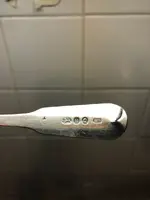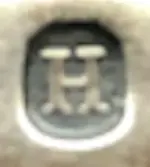The odd symbol at the right has nothing to do with the Isle of Man. It does look like a triskele, but that’s just a generic term for the decorative symbol of largely Celtic origins.
View attachment 1829912
The spoon may or may not be silver. Those are not official British Hallmarks. They’ve been applied by the manufacturer himself and, although he’s using the lion passant which would indicate it to be Sterling
IF it had been officially marked, it carries no guarantee of the metal or its purity when applied unofficially. It could be Sterling silver, silver of a lower purity, silver plate (but not electroplate), or a white metal imitation.
It’s misleading to say that “the Lion Passant is the British Sterling Mark” since there was absolutely nothing at the time which prohibited manufacturers using it on items which didn’t necessarily meet that standard. The standard is only guaranteed for the
full set of hallmarks from an assay office
including the town/city mark (which is absent on this piece). Neither does it have an “export mark”, by which I assume it is meant the King’s head. This is ostensibly a duty mark, indicating that duty has been paid on the piece and in use from 1784. However, again, it was not illegal to use such marks on uncertified pieces and many manufacturers did so. For silver that went for export, it was possible to reclaim the duty from our government if the piece had been officially hallmarked… but not otherwise.
In essence these are pseudo hallmarks applied by the manufacturer with no official status. There are three main reasons why some manufacturers did this (of which the second one was the most common):
- The maker was using silver, but wasn’t confident it would meet the Sterling standard and chose to avoid the cost of assaying a piece that might fail. In that case he would not be able to openly advertise the piece as silver and would be relying on his market reputation for its sale. Generally, only a handful of well-established manufacturers did this, but most usually they only applied their maker's mark... not a pseudo-set.
- The maker was using silver plate and applied pseudo marks with the intention of deceiving an unwary purchaser. This was common practice (including on pieces going for export), frowned upon but not illegal (in Britain), and is the usual explanation for the absence of a town/city mark.
- The maker was using a silver substitute and applied pseudo marks with the intention of deceiving the purchaser. Again, seen on both domestic and export pieces, frowned upon but not illegal (in Britain), and another explanation for the absence of a town/city mark.
Official date letters can only be interpreted if the town/city of assay is known. Manufacturers applying their own marks sometimes used the same sequences that assay offices used and sometimes used their own sequences, so those can’t be interpreted without knowing the maker. For an official date mark in combination with the duty mark, the capital serifed H could only be:
Chester 1804 or 1826
Dublin 1804 or 1828
Edinburgh 1788
Exeter 1804
Glasgow 1826
London 1803
Newcastle 1798
Sheffield 1801
Not Birmingham or York
However, take a closer look at that date letter and note that the bottom arms of the H have ‘club feet’ not serifs.
View attachment 1829915
Also, the full set of marks doesn’t represent a ‘matched set’ for any British assay office with respect to the shields and lozenges used. For sure that’s not an official mark and so the above dates might be completely spurious. Note also that, for pseudo marks, the spurious duty mark is not necessarily an indication of date either.
Without knowing the location of the maker (assuming British) or the actual date there are numerous possibilities for the ‘HS’ mark, including an unidentified maker in Sheffield, which is my guess on where this piece came from. I think it will probably be ‘fused plate’ (ie not electroplate) of the type sometimes known as ‘old Sheffield plate’ but more properly called ‘closed plate’ when used for things like cutlery. It was in common use in the first part of the 19th Century, before the advent of electroplate in 1840.








